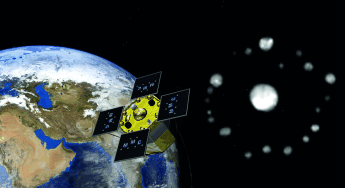Planet–satellite nanostructures from gold nanoparticles and RAFT star polymers

(Phys.org) —The cosmos in miniature: German researchers have produced nanoparticles surrounded by a group of smaller nanoparticles like a planet orbited by satellites. They equipped larger gold nanoparticles with special star-shaped polymers, which in turn bind to smaller gold nanoparticles. As the researchers report in the journal Angewandte Chemie, it is possible to precisely control the distance between the tiny "satellites" and their central "planet" by means of the molecular weight—and thus the chain length—of the polymers.
Like all humans, researchers like good aesthetics. They take pleasure in unusual nanoscopic architectures with ordered structures and are curious about what interesting physical properties are inherent to such structures. These properties can often be extremely useful. For example, nanoarchitectures consisting of a central nanoparticle surrounded by smaller nanoparticles at a precisely defined distance could be used as sensors, as "rulers" for measuring biological nano-objects, and as transport systems to deliver drugs specifically to tumor cells. However, researchers had not previously found a method to easily and efficiently produce a variety of planet–satellite nanosystems—a critical requirement for the investigation and practical use of such nanoarchitectures.
Christin Rossner and Philipp Vana at the University of Göttingen have now developed such a technique. At its center are polymers produced by a RAFT (reversible addition–fragmentation chain transfer) polymerization. RAFT is a technique for the targeted synthesis of polymers with a precisely defined degree of polymerization; it results in very uniform polymers with precisely controllable chain lengths. Because this is a controlled process, it is also possible to synthesize more complicated molecular architectures, such as comb-shaped or star-shaped polymers. Rossner and Vana chose to use star polymers consisting of a center with four side chains coming out like rays. The side chains have trithiocarbonate groups at their ends. These groups bind very well to gold surfaces.
The researchers treated gold nanoparticles with these star polymers. Two to three of the "rays" bind to the surface while the remaining one or two rays remain free and available to bind the smaller satellite gold nanoparticles later. The molecular weight of the star polymers—and thus the length of the rays—can be used to precisely control the distances between the planets and satellites. The satellites can also be equipped with polymer chains that have certain chemical groups on their ends. It is thus possible to make gold nanoparticle scaffolds with a variety of reactive groups at a defined distance form the central core.
More information: Rossner, C. and Vana, P. (2014), "Planet–Satellite Nanostructures Made To Order by RAFT Star Polymers." Angew. Chem. Int. Ed.. doi: 10.1002/anie.201406854
Journal information: Angewandte Chemie , Angewandte Chemie International Edition
Provided by Angewandte Chemie




















